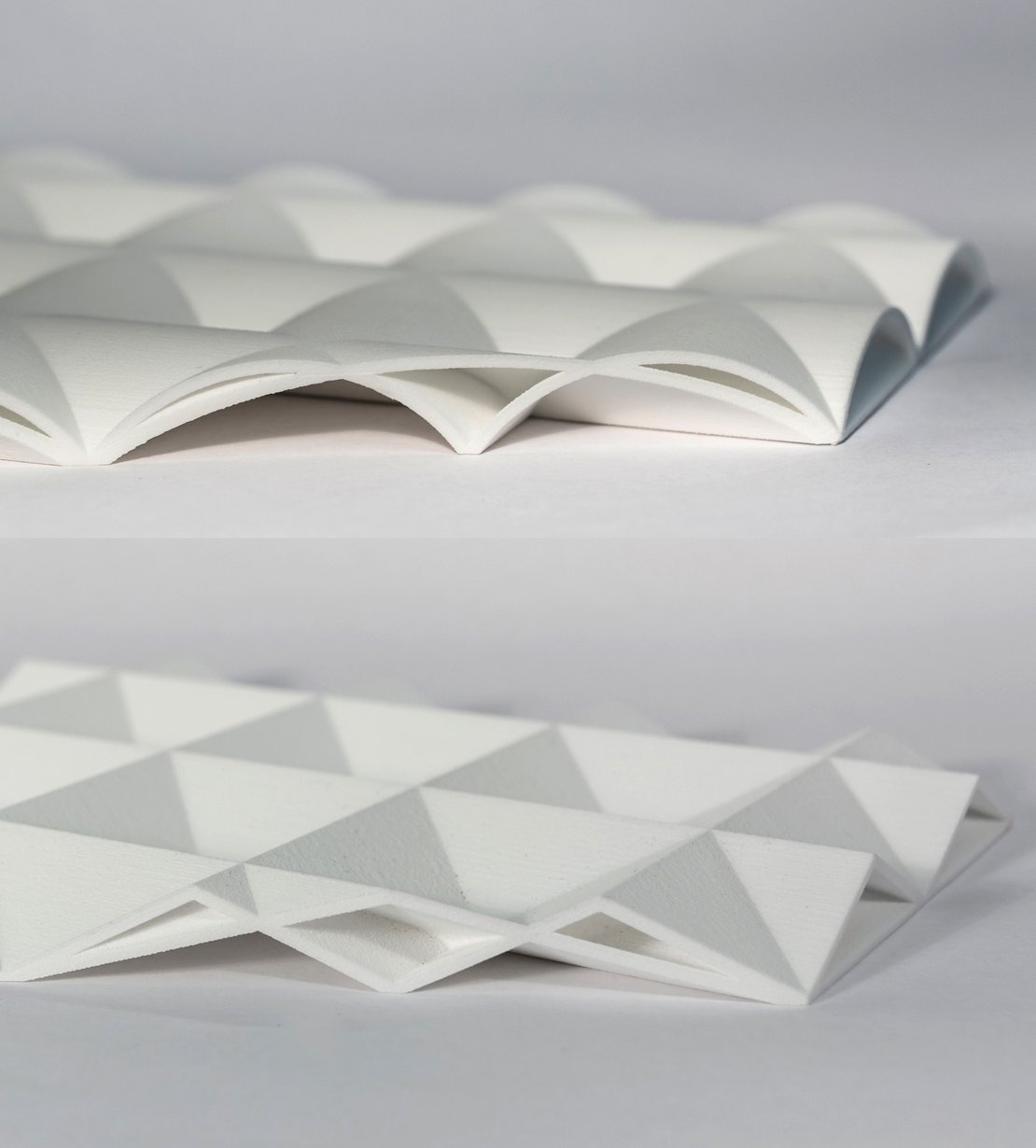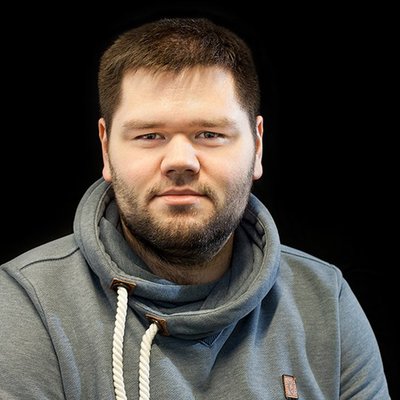Auflösung kompakter Bauteile mittels sich durchdringender, lastabtragender schalenförmiger Strukturen
Zentrales Ziel des TP C01 ist es, massive Betonbauteile auf Basis einer inneren Schalentragstruktur aufzulösen und auf diese Weise die Schalentragwirkung im Kleinen zu nutzen. In Schalenbauweise, die in Natur und Technik in vielfältigen Variationen zu finden ist, können komplexe Tragstrukturen bei sparsamstem Materialeinsatz ausgebildet werden. Während natürliche Schalenstrukturen bspw. als Schutzhülle für Kleinstlebewesen dienen oder als leichte Blütenblätter hohen Windkräften entgegenwirken, überspannt man im Bauwesen vor allem große Flächen. Im Vergleich zu Balken und Rahmentragwerken, bei denen mit steigender Spannweite die Biegebeanspruchung infolge Eigengewichts überproportional zunimmt, können räumlich gekrümmte Schalentragwerke mit minimalem Materialaufwand deutlich größere Spannweiten bewältigen. Im Idealfall herrschen in den dünnwandigen Strukturen ausschließlich Membranspannungen; statisch und bezüglich der Materialausnutzung ungünstige Biegespannungen werden vermieden. Im TP C01 wird eine Methode entwickelt, um Bauteile aller Art auf Basis einer inneren Schalentragwirkung aufzulösen. Eine weitere Variante der inneren Auflösung sind Faltwerkstrukturen.

Wissenschaftler

01062 Dresden

01062 Dresden

01219 Dresden
Kooperationen
Publikationen | Publications
Mester, L.; Klempt, V.; Wagner, F.; Scheerer, S.; Klarmann, S.; Vakaliuk, I.; Curbach, M.; Maas, H.-G.; Löhnert, S.; Klinkel, S. (2023) A Comparison of Multiscale Methods for the Modelling of Carbon-Reinforced Concrete Structures in: Ilki, A.; Çavunt, D.; Çavunt, Y. S. [eds.] Building for the Future: Durable, Sustainable, Resilient – Proc. of fib Symposium 2023, 05.–07.06.2023 in Istanbul (Turkey), publ. in: Lecture Notes in Civil Engineering 350, Cham: Springer, p. 1418–1427 – DOI: 10.1007/978-3-031-32511-3_145
Vakaliuk, I. (2022) Use of pervading internal shell-type substructures to dissolve compact components in: Curbach, M.; Marx, S.; Mechtcherine, V. [eds.] Beiträge zum 61. Forschungskolloquium mit 9. Jahrestagung des DAfStb, 26./27.09.2022 in Dresden, p. 179–184 – DOI: 10.25368/2022.398
Vakaliuk, I.; Goertzen, T.; Scheerer, S.; Niemeyer, A. C.; Curbach, M. (2022) Initial numerical development of design procedures for TRC bioinspired shells in: Su-duo Xue, S.-d.; Wu, J.-z.; Sun, G.-j. [eds.] Innovation, Sustainability and Legacy – Proceedings of IASS/APCS 2022, 19.–22.09.2022 in Beijing (China), p. 2597–2608.
Vakaliuk, I.; Platen, J.; Klempt, V.; Scheerer, S.; Curbach, M.; Kaliske, M.; Löhnert, S. (2022) Development of load-bearing shell-type TRC structures – initial numerical analysis in: Stokkeland, S.; Braarud, H. C. [eds.] Concrete Innovation for Sustainability – Proc. for the 6th fib International Congress 2022, 12.–16.06.2022 in Oslo (Norway), Oslo: Novus Press, p. 1799–1808.
Vakaliuk, I.; Scheerer, S.; Curbach, M. (2022) Initial laboratory test of load-bearing shell-shaped TRC structures in: Stokkeland, S.; Braarud, H. C. [eds.] Concrete Innovation for Sustainability – Proc. for the 6th fib International Congress 2022, 12.–16.06.2022 in Oslo (Norway), Oslo: Novus Press, p. 675-684.
Vakaliuk, I.; Scheerer, S.; Curbach, M. (2024) Numerical Analysis of Textile Reinforced Concrete Shells: Force Interaction and Failure Types in: CivilEng 5, issue 1/Special Issue Feature Papers in CivilEng, p. 224–246 – DOI: https://doi.org/10.3390/civileng5010012 (first publ. 2023 in: Preprints, 2023120700 – DOI: https://doi.org/10.20944/preprints202312.0700.v1, modified)
Vakaliuk, I.; Scheerer, S.; Curbach, M. (2024) The Numerical Analysis of Textile Reinforced Concrete Shells: Basic Principles in: Appl. Sci. 14, issue 5, 2140 – DOI: https://doi.org/10.3390/app14052140 (first publ. 2023 in: Preprints, 2023120705 – DOI: https://doi.org/10.20944/preprints202312.0705.v1, modified)
Vakaliuk, I.; Scheerer, S.; Curbach, M. (2023) Vacuum-Assisted Die Casting Method for the Production of Filigree Textile-Reinforced Concrete Structures in: Buildings 13, issue 10 (Spec. Issue Research on the Performance of Non-metallic Reinforced Concrete), 2641 – DOI: 10.3390/buildings13102641
Wiesenhuetter, S.; Goertzen, T.; Vakaliuk, I.; Curbach, M.; Scheerer, S.; Niemeyer, A. C.; Noennig, J. R. (2023) Triply Periodic Minimal Surfaces – A Novel Design Approach for Lightweight CRC Structures in: Ilki, A.; Çavunt, D.; Çavunt, Y. S. [eds.] Building for the Future: Durable, Sustainable, Resilient – Proc. of fib Symposium 2023, 05.–07.06.2023 in Istanbul (Turkey), publ. in: Lecture Notes in Civil Engineering, Vol 350, Cham: Springer, p. 1449–1458 – DOI: 10.1007/978-3-031-32511-3_148
Zdanowicz, K.; Vakaliuk, I.; Beckmann, B.; Marx, S. (2022) Two-dimensional strain measurements of chemically prestressed textile reinforced concrete slabs with distributed fibre optic sensors in: Stokkeland, S.; Braarud, H. C. [eds.] Concrete Innovation for Sustainability – Proc. for the 6th fib International Congress 2022, 12.–16.06.2022 in Oslo (Norway), Oslo: Novus Press, p. 666–674.
Vorträge | Oral presentations
Vakaliuk, I. (2022) Generative design in textile reinforced concrete structures oral presentation at: AdvanceAEC Autumn School 2022, 11.10.2022 in Stuttgart
Studentische Arbeiten | Student's works
Abimbola, O. D. (2021) Conceptual development of the carbon reinforcement unconstrained laying algorithm [Projektarbeit | project work].
Sezallari, K. (2021) Development of a multifunctional interface between ConFEM software and Grasshopper 3D environment [Projektarbeit | project work].
Abimbola, O. D. (2022) Development of the programming GH tool for the production of thin-walled TRC structures using methods of 3D concrete printing [Masterarbeit | master’s thesis]. (mit | with D01)
Byron, J. (2022) Precast Modular Bridge Design made of Ultra High- Performance Concrete [Projektarbeit | project work].
Sezallari, K. (2022): Form follows environment – Flexible Glass Façade optimized with 3D printing and Grasshopper form optimization [Masterarbeit | master’s thesis].
Marcillo Delgado, E. (2023) Influence of the permanent formwork elements on the structural performance of the cellular TRC structures [Masterarbeit | master’s thesis].
Chakkarathodi, A. K. (2023) Development of the workflow for the analysis of the TRC structure’s geometry using methods of 3D scanning [Masterarbeit | master’s thesis]. (mit | with S)



